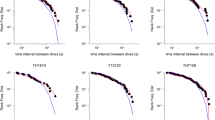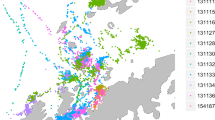Abstract
Marine birds and mammals move between various habitats during the day as they engage in behaviors related to resting, sleeping, preening, feeding, and breeding. The per capita rates of movement between these habitats, and hence the habitat occupancy dynamics, often are functions of environmental variables such as tide height, solar elevation, wind speed, and temperature. If the system recovers rapidly after disturbance, differential equation models of occupancy dynamics can be reduced to algebraic equations on two time scales. Identification of environmental factors that influence movement between habitats requires time series census data collected in both the absence and presence of disturbance.
Similar content being viewed by others
References
Amlaner, C.J. Jr., Stout, J.F., 1978. Aggressive communication by Larus glaucescens Part VI: Interactions of territory residents with a remotely controled, locomotory model. Behaviour 66, 223–251.
Burnham, K.P., Anderson, D.R., 2002. Model Selection and Multi-Model Inference: A Practical Information-Theoretic Approach, 2nd edn: Springer, New York.
Damania, S.P., Phillips, K.W., Henson, S.M., Hayward, J.H., 2005. Habitat patch occupancy dynamics of Glaucous-winged Gulls (Larus glaucescens) II: A continuous-time model. Natural Resource Modeling, 18, 469–499.
Delius, J.D., 1970. Effect of daytime, tides and other factors on some activities of lesser Black-backed Gulls, Larus fuscus. Rev. Comportement Anim. 4, 3–11.
Drent, R.H., 1967. Functional aspects of incubation in the Herring Gull (Larus argentatus Pont.). Behav. Suppl. 17, 1–32.
Galusha, J.G., Amlaner, C.J., 1978. The effects of diurnal and tidal periodicities in the numbers and activities of Herring Gulls Larus argentatus in a colony. Ibis 120, 322–328.
Hayward, J.L., Gillett, W.H., Stout, J.F., 1977. Aggressive communication by Larus glaucescens Part V: Orientation and sequences of behavior. Behaviour 62, 236–276.
Hayward, J.L., Henson, S.M., Logan, C.J., Parris, C.R., Meyer, M.W., Dennis, B., 2005. Predicting numbers of hauled-out harbour seals: A mathematical model. J. Appl. Ecol. 42, 108–117
Henson, S.M., Hayward, J.L., Burden, C.M., Logan, C.J., Galusha, J.G., 2004. Predicting dynamics of aggregate loafing behavior in Glaucous-winged Gulls (Larus glaucescens) at a Washington colony. Auk 121, 380–390.
Hoppensteadt, F.C., 1975. Mathematical Theories of Populations: Demographics, Genetics and Epidemics. Regional Conference Series in Applied Mathematics, vol. 20. SIAM, Philadelphia, PA.
Lin, C.C., Segel, L.A., 1988. Mathematics Applied to Deterministic Problems in the Natural Sciences. SIAM, Philadelphia, PA.
Patterson, I.J., 1965. Timing and spacing of broods in the Black-headed Gull Larus ridibundus L. Ibis 107, 433–459.
Schneider, D.C., Payne, P.M., 1983. Factors affecting haul-out of harbor seals at a site in southeastern Massachusetts. J. Mammal. 64, 518–520.
Stewart, B.S., 1984. Diurnal hauling patterns of harbor seals at San Miguel Island, California. J. Wildl. Manage. 48, 1459–1461.
Thompson, P.M., Fedak, M.A., McConnell, B.J., Nicholas, K.S., 1989. Seasonal and sex-related variation in the activity patterns of common seals (Phoca vitulina). J. Appl. Ecol. 26, 521–535.
Thompson, P.M., Tollit, D.J., Wood, D., Corpe, H.M., Hammond, P.S., Mackay, A., 1997. Estimating harbour seal abundance and status in an estuarine habitat in northeast Scotland. J. Appl. Ecol. 38, 117–125.
Tikhonov, A.N., Vasil'eva, A.B., Sveshnikov, A.G., 1985. Differential Equations. Springer, Berlin.
Watts, P., 1992. Thermal constraints on hauling out by harbour seals (Phoca vitulina). Can. J. Zool. 70, 553–560.
Author information
Authors and Affiliations
Corresponding author
Rights and permissions
About this article
Cite this article
Henson, S.M., Hayward, J.L. & Damania, S.P. Identifying Environmental Determinants of Diurnal Distribution in Marine Birds and Mammals. Bull. Math. Biol. 68, 467–482 (2006). https://doi.org/10.1007/s11538-005-9009-0
Received:
Accepted:
Published:
Issue Date:
DOI: https://doi.org/10.1007/s11538-005-9009-0




